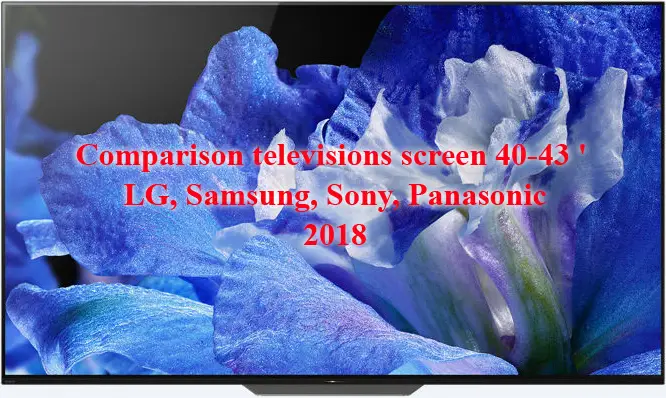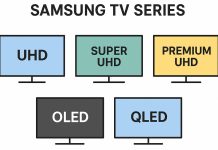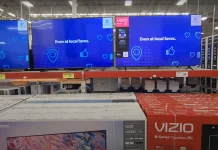When considering 40-43 inch TVs, ideal for small rooms, leading manufacturers such as LG, Samsung, Sony, and Panasonic offered various models in 2018, each with its unique features.
Screen Size
LG and Sony provide 43-inch options, which might be a slight advantage for those looking for a larger screen. On the other hand, Samsung and Panasonic focus mainly on 40-inch models.
Display Technology
LG traditionally uses IPS panels, offering excellent viewing angles. Some LG models feature RGBW matrices, which improve brightness but may slightly affect color accuracy. Samsung uses VA technology, which delivers deeper blacks but narrower viewing angles. Panasonic and Sony use a mix of both VA and IPS panels, depending on the model. Generally, VA panels are found in entry-level models, while IPS panels are used in higher-end models for better visibility from different angles.
Frame Rate
Sony and Panasonic offer a limited number of models with a native 120Hz refresh rate, ideal for gaming or fast-moving content. However, for most users who watch standard video, a 60Hz refresh rate is more than enough, as most content doesn’t exceed this frame rate.
Color Depth
All these brands feature 8-bit panels, though many models use FRC (Frame Rate Control) to simulate 10-bit color depth, ensuring smoother gradients and more vibrant colors. This is important for users who prioritize high-quality visual performance.
Resolution
Most models from LG, Samsung, and Panasonic come with UHD resolution, which provides clear and detailed images, especially on larger screens. Sony, however, still offers Full HD panels in some of its mid-range models. This trend towards UHD resolution is becoming more widespread, especially as Full HD panels are phased out.
Sound Quality
Most of these TVs come with two 10W speakers, which may not provide the best sound quality for an immersive experience. To improve audio, external sound systems like soundbars are recommended.
Tuners
There has been a trend towards standardization of tuners, supporting a variety of formats. While older models might only support ethernet and cable tuners, newer models are often equipped with satellite tuners as well. It’s important to note the regional differences: North American models support ATSC tuners, while European models use DVB tuners.
Operating Systems
Each manufacturer has developed its own smart TV platform. LG uses webOS, Samsung has Tizen, Sony features Android TV, and Panasonic uses my Home Screen. Despite differences in interfaces, the functionality is quite similar, and the choice often comes down to personal preference.
LG, Samsung, Sony and Panasonic 2018 comparison chart
| Brand | Model | Year | Region | Panel Type | Screen size | Series | Motion | Refresh Rate Hz | PMI | Bit screen | Screen resolution | Processor | Tuner | OS | Audio | Ports | LAN |
|---|---|---|---|---|---|---|---|---|---|---|---|---|---|---|---|---|---|
| LG | 43UK6950PLB | 2018 | IPS RGBW | 43 | 7 | 120 | 60 | 10 bits (8bits+FRC) | UHD | Quad | DVB | webOS 4.0 | 2x10W | 4xHDMI 2.0;2xUSB 2.0 | Yes | ||
| LG | 43UK6500LLA | 2018 | IPS | 43 | 6 | 120 | 60 | 10 bits (8bits+FRC) | UHD | Quad | DVB | webOS 4.0 | 2x10W | 4xHDMI 2.0;2xUSB 2.0 | Yes | ||
| LG | 43UK6500PLA | 2018 | IPS RGBW | 43 | 6 | 100 | 60 | 10 bits (8bits+FRC) | UHD | Quad | DVB | webOS 4.0 | 2x10W | 4xHDMI 2.0;2xUSB 2.0 | Yes | ||
| LG | 43UK6500AUA | 2018 | VA RGBW | 43 | 6 | 120 | 60 | 10 bits (8bits+FRC) | UHD | Quad | ATSC, Clear QAM | webOS 4.0 | 2x10W | 4xHDMI 2.0;2xUSB 2.0 | Yes | ||
| LG | 43UK6300LLB | 2018 | IPS RGBW | 43 | 6 | 120 | 60 | 10 bits (8bits+FRC) | UHD | Quad | DVB | webOS 4.0 | 2x10W | 3xHDMI 2.0;2xUSB 2.0 | Yes | ||
| LG | 43UK6300PUE | 2018 | IPS RGBW | 43 | 6 | 120 | 60 | 10 bits (8bits+FRC) | UHD | Quad | ATSC, Clear QAM | webOS 4.0 | 2x10W | 3xHDMI 2.0;2xUSB 2.0 | Yes | ||
| LG | 43UK6470PLC | 2018 | IPS RGBW | 43 | 6 | 120 | 60 | 1600 | 10 bits (8bits+FRC) | UHD | Quad | DVB | webOS 4.0 | 2x10W | 3xHDMI 2.0;2xUSB 2.0 | Yes | |
| LG | 43UK6400PLF | 2018 | IPS RGBW | 43 | 6 | 120 | 60 | 1600 | 10 bits (8bits+FRC) | UHD | Quad | DVB | webOS 4.0 | 2x10W | 3xHDMI 2.0;2xUSB 2.0 | Yes | |
| LG | 43LK6100PLB | 2018 | IPS | 43 | 6 | 120 | 60 | 8bits | Full HD | Quad | DVB | webOS 4.0 | 2x10W | 2xHDMI 1.4;1xUSB 2.0 | Yes | ||
| LG | 43LK5900PLA | 2018 | IPS | 43 | 5 | 120 | 60 | 8bits | Full HD | Quad | DVB | webOS 4.0 | 2x5W | 2xHDMI 1.4;1xUSB 2.0 | Yes | ||
| LG | 43LK5100PLA | 2018 | IPS | 43 | 5 | 120 | 60 | 8bits | Full HD | Quad | DVB | webOS 4.0 | 2x5W | 2xHDMI 1.4;1xUSB 2.0 | Yes | ||
| LG | 43LK5000PLA | 2018 | IPS | 43 | 5 | 120 | 60 | 8bits | Full HD | 1 | X | webOS 4.0 | 2x5W | 2xHDMI 1.4;1xUSB 2.0 | No | ||
| LG | 43UP7500PVB | 2021 | IPS | 43 | 7 | 100 | 50 | 10 bits (8bits+FRC) | UHD | Quad | DVB | webOS 6.0 | 2x10W | 3xHDMI 2.0;2xUSB 2.0 | Yes | ||
| LG | 43UN7000PUB | 2020 | IPS | 43 | 7 | 100 | 60 | 10 bits (8bits+FRC) | UHD | Quad | ATSC, Clear QAM | webOS 5.0 | 2x10W | 3xHDMI 2.0;2xUSB 2.0 | Yes | ||
| LG | 43UN7300PUF | 2020 | IPS | 43 | 7 | 100 | 60 | 10 bits (8bits+FRC) | UHD | Quad | ATSC, Clear QAM | webOS 5.0 | 2x10W | 3xHDMI 2.0;2xUSB 2.0 | Yes | ||
| LG | 43UN7100PUE | 2020 | IPS | 43 | 6 | 100 | 60 | 10 bits (8bits+FRC) | UHD | Quad | ATSC, Clear QAM | webOS 5.0 | 2x10W | 3xHDMI 2.0;2xUSB 2.0 | Yes | ||
| LG | 43UP7700PVB | 2021 | IPS | 43 | 7 | 100 | 50 | 10 bits (8bits+FRC) | UHD | Quad | DVB | webOS 6.0 | 2x10W | 3xHDMI 2.0;2xUSB 2.0 | Yes | ||
| LG | 43UN8500PUC | 2020 | IPS | 43 | 8 | 120 | 60 | 10 bits (8bits+FRC) | UHD | Quad | ATSC, Clear QAM | webOS 5.0 | 2x20W | 4xHDMI 2.0;3xUSB 2.0 | Yes | ||
| LG | 43UP8000PVB | 2021 | IPS | 43 | 7 | 100 | 50 | 10 bits (8bits+FRC) | UHD | Quad | DVB | webOS 6.0 | 2x10W | 3xHDMI 2.0;2xUSB 2.0 | Yes |






